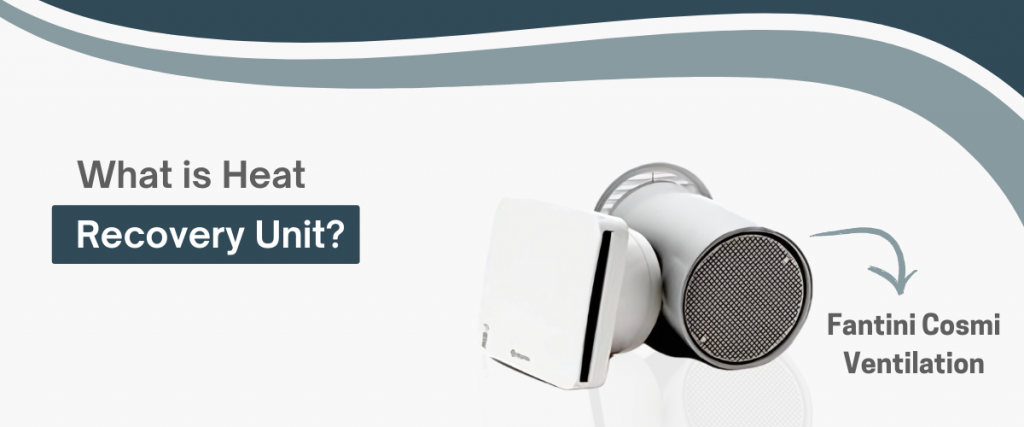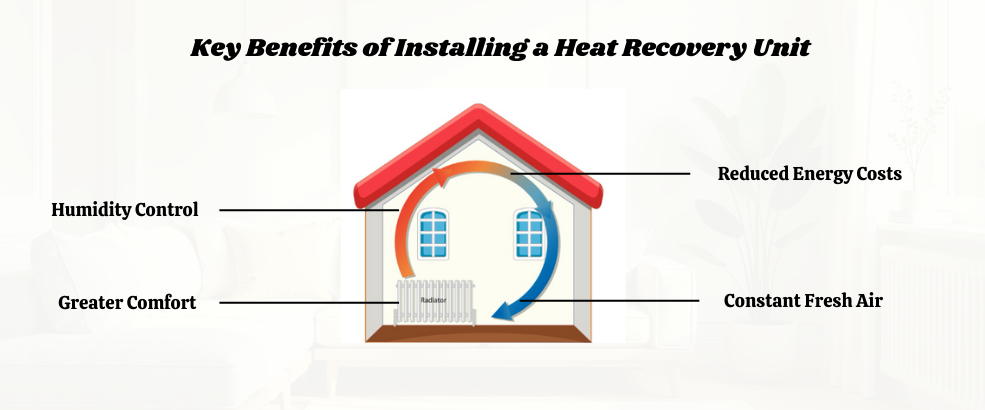Latest Blog
What Is a Heat Recovery Unit?

A heat recovery unit is a clever device that takes heat from outgoing air in your home and uses it to pre-warm the fresh air coming in. This simple system boosts energy efficiency, creating a more comfortable living space year-round. As more homeowners look for ways to save on bills and help the environment, heat recovery units are now popular features in modern properties.
They can help balance your home’s temperature, lower dampness, and improve the air you breathe. In a world where energy prices rise and air quality matters more than ever, understanding what a heat recovery unit offers is a smart step toward better living.
How Heat Recovery Units Work
A heat recovery ventilator does something that sounds quite magical, but the science is straightforward. The unit quietly replaces stale indoor air with fresh outdoor air, while cleverly capturing heat from the old air before it leaves. Here’s how the process works in a typical home heat recovery system.
Warm, used air from kitchens, bathrooms, and living spaces is drawn into the system. At the same time, fresh but usually cold air is pulled in from outside. These two air streams pass through a heat exchanger inside the unit. The heat exchanger allows the outgoing air to transfer much of its warmth to the incoming air, without the two airflows actually mixing. The result? You get a house filled with filtered, pre-warmed air, and little heat energy escapes.
This process means your boiler or heat pump doesn’t have to work as hard to keep rooms cosy. Alongside energy savings, a good home heat recovery system improves indoor air quality by filtering dust, pollen, and other outdoor pollutants before they enter your home.
Typical Components-
- Heat Exchanger: The heart of the unit, where heat swap happens.
- Fans: Move air in and out, maintaining a steady flow.
- Filters: Clean dust, dirt, and allergens from the incoming air.
- Controls: Let you adjust airflow for different needs.
The system quietly manages all this behind the scenes, keeping your home healthier and your bills lower.
Key Benefits of Installing a Heat Recovery Unit
What makes a home heat recovery system a worthwhile addition to your home? The advantages reach beyond comfort and savings. It does not matter if you’re building new or upgrading an older home; these units meet the everyday needs of modern living.

- Reduced Energy Costs: By recycling heat that would otherwise be lost, you spend less on heating.
- Constant Fresh Air: Enjoy a steady flow of filtered outside air, even with windows closed.
- Better Humidity Control: The system manages moisture, helping to avoid damp and mould.
- Greater Comfort: Say goodbye to stuffy rooms or cold draughts.
- Lower Environmental Impact: Every kilowatt saved cuts your carbon footprint.
Using a heat recovery system in your setup means you achieve all of this with little fuss. It slots neatly into new builds but can also be retrofitted in existing homes with planning.
Health and Comfort Improvements
Clean air makes a difference you can feel. Heat recovery units do more than just warm up a room; they also strip out many airborne threats. The filters in these systems catch pollen, dust, exhaust fumes, and other nasties before they come inside. Families with allergies often notice fewer sniffles and chesty coughs. Less dust and lower humidity can reduce asthma symptoms, making the whole home feel healthier.
Experts highlight that good ventilation means fewer respiratory problems. Dry indoor air can cause chapped lips and irritated eyes, while overly damp homes breed mould and mites. A recovery unit balances this out. By keeping fresh air moving (but not freezing), homes feel alive, not stuffy.
Environmental and Cost Savings
There’s no trick to saving money here; you simply use the heat you already have. Standard homes lose a lot of warmth through vents or open windows, especially in winter. A heat recovery unit holds onto up to 90 percent of that heat, recycling it. This lowers how much you spend on heating your home.
Below, see how heat loss compares:
| Method | Estimated Heat Loss (%) |
|---|---|
| Traditional Ventilation | 40–50 |
| Heat Recovery Unit | 10–20 |
Actual savings will depend on your home’s insulation, size, and how you use heating. Many people find their heating bills drop by up to 25 percent after fitting a unit. Less wasted energy also means fewer carbon emissions, making each household’s footprint smaller. Simply put, a heat recovery unit is good for your pocket and the planet.
Choosing the Right Heat Recovery System for Your Home
Shopping for a heat recovery system isn’t about picking the fanciest model; it’s about matching the right setup to your home’s needs. First, think about the size of your property. A compact flat will suit a different unit from a four-bedroom family house.

Key points to consider-
- Home Size: Measure the floor area to estimate airflow needs.
- Number of Rooms: More rooms may need larger or multiple units.
- Installation: Ducted whole-house units work best in new builds. For flats or retrofits, single room ventilation heat recovery units offer a tidy solution.
- Maintenance: Filters need checking every few months; clean fans run quieter and last longer.
- Noise Levels: Check decibel ratings if you’re sensitive to sound.
Professional installation is always best. Experts assess your property and fit the system so it runs smoothly from day one. A good installer will also show you how to get the best out of features, like timers or boost modes. Regular upkeep keeps the air sweet and energy savings high.
The Bottom Line
A heat recovery unit does more than warm your home. It cuts energy use, balances humidity, and fills rooms with cleaner air. Modern life means more time indoors, so investing in smart air solutions makes sense for comfort, health, and peace of mind. Take a look at your current ventilation. Is it costing you too much in comfort or cash? Your home could become healthier and cheaper to run by choosing the right system today.
